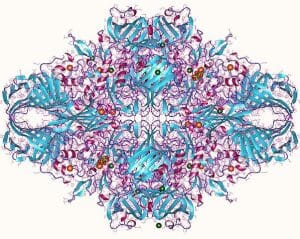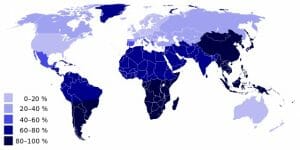Lactase Definition
Lactase is an enzyme found in the mammalian small intestine that digests lactose, which is a sugar found in milk. Mammals use milk to feed their young, and in most mammals, the activity of lactase decreases after the young is weaned and can consume other foods. Lactose tolerance (also called lactose persistence), or being able to digest milk through adulthood, is a genetic mutation; the “default” state in humans, like other mammals, is lactose intolerance after childhood.
Function of Lactase
Lactase’s function is to break down lactose into the two simple sugars it is made up of, glucose and galactose. Breaking down lactose into its simple sugars makes it possible for it to be absorbed via the small intestine and used by the body. If lactose is not broken down, it will pass through the digestive tract without being absorbed.
Infant mammals rely on nutrients from their mother’s milk to survive. During infancy, lactase activity is high so that the body can obtain nutrients from this important food source. However, after a young mammal is weaned off of milk, the activity of lactase declines. Lactase is not needed since milk is not being consumed, and its production decreases. In humans, lactase production decreases by around age four. The exception is found in some humans that have lactose persistence and can produce lactose beyond early childhood.
Structure of Lactase
The gene that produces lactase is located on chromosome 2 in humans. The initial polypeptide, or chain of amino acids, that forms from this gene is called pre-pro-lactase. Pre-pro-lactase is a long chain of 1,927 amino acids. Parts of the chain are then removed as the polypeptide is converted into its mature form, lactase. Multiple chains are put together to form lactase, which is made up of four of the same subunits. Each subunit has 1023 amino acid residues for a total of 4092 amino acid residues. Lactase is a homotetramer molecule because it has four identical subunits.
This is an artist’s representation of lactase’s structure.

Lactose Intolerance
Primary Lactose Intolerance
Primary lactose intolerance is the most common type of lactose intolerance, and is usually what is referred to when describing lactose intolerance. Lactose intolerance is also called hypolactasia. It is the inability to digest lactose past childhood because not enough lactase is produced. Primary lactose intolerance is very common worldwide; 70 percent of humans are lactose intolerant after childhood. In the United States, a sizable minority of people—over one-third—are lactose intolerant. This number is still lower than what is seen in many other regions because the majority of people living in the United States today are of European descent, where rates of lactose permanence are relatively higher. By contrast, the vast majority of people living in Asia, certain parts of Africa, and Southern Europe, along with most Native Americans, are lactose intolerant. While they are able to consume milk and other dairy products when young, it gradually gets harder for their bodies to digest lactose. It can take as long as 20 years for a person to fully develop lactose intolerance.
Symptoms of lactose intolerance occur a short time after consuming dairy products. They include nausea, cramps, bloating, diarrhea and flatulence. There is no way to make the body produce more lactase, but there are a few ways to help treat lactose intolerance. Over-the-counter drops or capsules that contain lactase may be taken before consuming dairy products in order to supplement the lactase needed for digestion. Minimizing the amount of dairy products consumed and only consuming dairy during meals may minimize symptoms; consuming a small amount of milk during a meal, for example, may not cause gastrointestinal problems. The type of dairy consumed also has an effect on the severity of symptoms. Yogurt, which contains bacteria that ferments lactose, and hard cheeses, which are low in lactose, tend to cause fewer symptoms than other dairy products.
This graph shows the percentage of people in each country that have difficulty digesting lactose past childhood.

Secondary Lactose Intolerance
Secondary lactose intolerance occurs when lactase production decreases due to an injury or illness that causes damage to the lining of the small intestine. Celiac disease, surgery, overgrowth of bacteria, and Crohn’s disease can all cause secondary lactose intolerance. This condition may be treated by treating of the underlying illness or injury that is causing the intolerance; when the cause is treated, the lactose intolerance symptoms will also go away.
Congenital Lactose Intolerance
Congenital lactose intolerance is very rare. It is an autosomal recessive disorder that causes a baby to be born with the inability to digest lactose because his or her body does not produce any lactase. This is a huge problem since babies only consume milk! However, it can be treated by giving the baby a special lactose-free formula to drink. If the baby does not drink lactose-free formula and only consumes breast milk or regular formula, it will suffer extreme dehydration and weight loss from being unable to digest lactose.
Related Biology Terms
- Lactose – Also known as “milk sugar”, it is made up of glucose and galactose and digested by lactase.
- Enzymes – Proteins that catalyze chemical reactions.
- Polypeptide – A molecule consisting of a long chain of amino acids.
- Digestion – The process of breaking down food so that the body can absorb and use its nutrients.
Quiz
1. When does lactase production decrease in mammals?
A. Around the age of four.
B. When the mammal is weaned.
C. When the mammal reaches adulthood.
D. Lactase production does not decrease in mammals.
2. How can the symptoms of lactose intolerance be reduced?
A. Taking lactose-containing capsules
B. Avoiding/minimizing the amount of dairy consumed
C. Consuming certain dairy products over others, like yogurt
D. All of the above
3. Which type of lactose intolerance occurs due to an illness or injury?
A. Primary lactose intolerance
B. Secondary lactose intolerance
C. Congenital lactose intolerance
